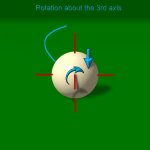I know this has been discussed ad nauseum but I need a little help conceptually on this. I understand that swerve is caused by rotation about the axis that goes from the front to the back of the ball, as if the cue stick were penetrating though the ball. I made the following diagram way back:

Now if I hit with a downward angle with, say 1:30 english, there is a vertical vector component that causes rotation around that axis, I call it the "swerve axis" or "3rd axis" in the drawing. If I hit the same shot with a perfectly level cue there is no noticeable swerve. Here's my question: If I hit at 1:30 and a level cue, the tip is striking the ball at 7:30 on the tip. If the "lower left" part of the tip is hitting the "upper right" part of the ball, this causes the ball to squirt left. However, the tip is not just pushing the ball to the left. It is also pushing down on the ball, even with a level cue. It seems to me that a level cue DOES impart rotation around the swerve axis. If the cue shaft were like an I beam it would impart more downward force than a low deflection shaft, and if I hit hard it would push down more than soft.
Am I correct to say that rotation about the swerve axis does occur with a level cue, but the magnitude is small enough not to be noticeable? Has anyone compared the size of this force to that of a cue that is angled downward?

Now if I hit with a downward angle with, say 1:30 english, there is a vertical vector component that causes rotation around that axis, I call it the "swerve axis" or "3rd axis" in the drawing. If I hit the same shot with a perfectly level cue there is no noticeable swerve. Here's my question: If I hit at 1:30 and a level cue, the tip is striking the ball at 7:30 on the tip. If the "lower left" part of the tip is hitting the "upper right" part of the ball, this causes the ball to squirt left. However, the tip is not just pushing the ball to the left. It is also pushing down on the ball, even with a level cue. It seems to me that a level cue DOES impart rotation around the swerve axis. If the cue shaft were like an I beam it would impart more downward force than a low deflection shaft, and if I hit hard it would push down more than soft.
Am I correct to say that rotation about the swerve axis does occur with a level cue, but the magnitude is small enough not to be noticeable? Has anyone compared the size of this force to that of a cue that is angled downward?